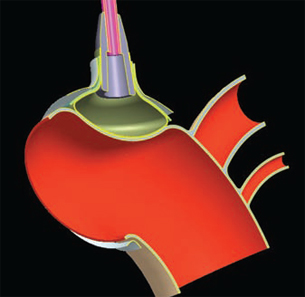January 1, 2009
By Lynn Manning
About five million Americans suffer from the debilitating and progressive effects of heart failure, with 500,000 new cases diagnosed each year. The disease can result from hardening of the arteries, heart attack, high blood pressure, diabetes, heart muscle infection, lung disease, or valve disorders and can be fatal when the heart is unable to provide sufficient blood flow to the body.
Treatment for heart failure (HF) ranges from medicines to surgical repairs and from mechanical devices to transplants. And while no single therapy works for everyone, each has its side effects or risks. Dr. William Peters, a cardiothoracic surgeon and research fellow at Auckland City Hospital in New Zealand, thinks there must be a better way.
“I’ve always had a strong interest in devices to support the failing heart,” he says. After commercial success with a minimally invasive bypass system he invented, Peters turned his efforts to a device less invasive and more reliable than existing technologies. “I was looking for a device that would not involve contact with the blood.”
At the time Peters began designing, common implanted devices such as left-ventricular assist devices — while lifesavers for people awaiting transplants or recovering from open-heart surgery — involve surgical connection with heart and arterial tissue and require patients to remain on blood thinners, raising the possibility of bleeding and stroke. Reliability has been also been an issue with some heart-assist devices.
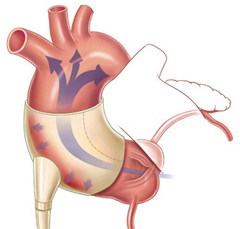 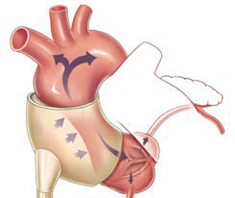 Figure 1: Sunshine Heart’s novel C-Pulse pump consists of a cuff encircling the aorta, and a balloon that inflates (right) and deflates to enhance blood flow anddecrease the heart’s workload. |
Pump works from outside the heart
Peters determined that his device would work inside the body but outside the bloodstream. It is called the C-Pulse and consists of a biocompatible polymer cuff that wraps around the aorta (the main blood vessel that carries oxygenated blood from the heart to the rest of the body); it contains a balloon that inflates and deflates against the vessel’s external wall (see Figure 1). The positive and negative pressure of the balloon make the aorta pulsate in time with the heart, augmenting blood flow through the circulatory system and reducing strain on the diseased heart. A battery-powered pump worn outside the body provides power (see Figure 2).
Peters patented his pump idea and formed a company, Sunshine Heart, to develop and test the device, initially on the bench and then in sheep. But once animal trials were successful and the device was ready to be scaled up to a human model, the company decided it needed a more sophisticated approach to the design and development process than the empirical, build-and-test approach they’d been using. The goal was not only to reduce lead-time, but to ensure that long-term performance would satisfy established product requirements for the medical device industry.
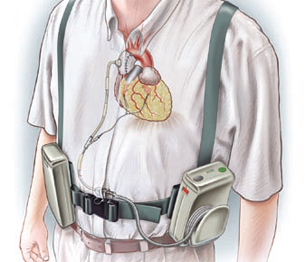 Figure 2: A lead from the external power source (driver) connects to a catheter inside the body attached to the implanted device (cuff), which is wrapped around the exteriorof the heart’s ascending aorta. |
FEA optimizes fatigue performance
“The average human heart rate of 80 beats a minute equates to 42 million inflation cycles a year,” says Scott Miller, manager of mechanical engineering at Sunshine Heart. “The accumulated stress, especially on a polymer, was the design challenge, and C-Pulse is essentially a permanent implant. To ensure that our physical design solution was optimized to give us the long-term fatigue performance required, we decided to look at it…using finite element analysis.”
Miller and his product development team worked with Matrix Applied Computing Ltd. of New Zealand for its technical software services. Matrix used Abaqus/Standard simulation software from SIMULIA to model the behavior of the C-Pulse cuff and balloon interacting with the aorta.
“The FEA analysis was an iterative process that required some very unique approaches because of the way our device worked, the materials we were using, and how the device is actually assembled,” says Miller. The balloon had to be easy to manipulate during implant surgery; conform to the shape of the aorta; have the strength and flexibility to “snap through” from concave to convex and back again repeatedly; compress the artery; and perform reliably from initial inflation through years of use — all within a very limited space. The goal of the FEA modeling was to accurately represent the real-world behavior of the device in order to guide design decisions and optimize the C-Pulse’s performance through every stage of this process.
Element & materials choices are critical
As a starting point for the FEA analysis, Sunshine Heart provided Matrix with concave and convex PTC Pro/ENGINEER models of the device (see Figure 3).
According to Don Campbell, principal engineering analyst for Matrix, “It was an interesting challenge. Our analysis involved modeling hyperelastic material; a fabric membrane; simplified biological material for the aorta; contact, large strain, and a staged assembly process.”
|
To determine the correct elements to use for modeling the artery, cuff, and balloon, Matrix created a series of test models. Quadrilateral shell elements turned out to be acceptable for the bulk of the parametric design studies (including determining the all-important optimum thickness of the balloon). But for modeling surface strains affecting the balloon in the fillet radius region (a critically important area where failures of the very earliest designs had occurred), hexahedron solid brick elements were chosen for more precise results using substructuring techniques with results from the shell model driving the solid element analysis.
The material-modeling portion of the analysis was constrained by physiology and anatomy studies that had already been conducted. “We were given pre-existing data for the biocompatible material (a polymer approved for medical device applications) from which the device would be manufactured,” says Campbell. “The Ogden hyperelastic material model in Abaqus provided an excellent fit with the experimental data.” The Ogden model is often used to model rubber-like materials.
Modeling the “snap through” function
With the FEA models of the C-Pulse set up, Matrix ran simulations to determine what shape the device’s balloon should be during surgical implantation (starting with a convex configuration turned out to be most effective at minimizing strain). Next they simulated the complete balloon “snap through” motion of convex to concave and back again (see Figure 5).
“The complexity of the analysis was less in its geometric difficulty or problem size, but more in the simulation of the continuous, alternating process,” says Campbell. “The strain on the balloon varied from the outer to the inner surface of the material as it snapped through, so the total strain we were analyzing was a combination of stretching and bending. During the simulation cycle, the location of peak strain in the fillet actually moved from the minor to the major axis of the oval-shaped balloon.”
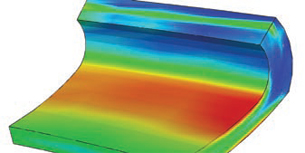 Figure 4: Abaqus FEA submodel solution showing variation of strain through the wall. |
Matrix ran its simulations as quarter models, using the assumption of symmetry to cut down on processing time and aid solution convergence. “There were some approximations with the quarter model since an aorta is not a straight pipe, but has some curvature,” Campbell says. “However, for the purpose of optimizing the design, the lack of true quarter symmetry was thought to have a minimal effect on the ultimate design parameters. This approach also let us perform a large number of parametric runs in a reasonable amount of time.”
The ultimate goal of the FEA analysis was to arrive at a device shape with the least variation of strain amplitude and the maximum mean compressive strain during an operational cycle. Says Campbell, “It was a project with interesting physics and the final model we came up with has performed very well in the test environment.”
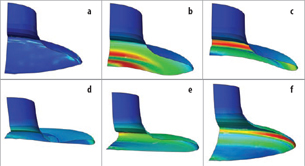 Figure 5: This series of images (a-f) shows an Abaqus FEA strain analysis of the “snap through” of the balloon membrane. Note how the area of maximum strain (red) moves from the short axis (b and c) to the long axis (f) from start to end of the cycle. |
FEA provides final design solution
The FEA models more than met Sunshine Heart’s requirements. “We arrived at a design solution the first time through and haven’t needed any additional FEA since then,” says Miller. His group has subsequently proven that the solution holds true for different sizes, allowing for tailoring the device to individual patients.
And the durability of the C-Pulse design is being borne out by ongoing testing, Miller notes. “We have been running devices day and night literally for years now: the test machine requires regular maintenance because the C-Pulse keeps wearing the test unit out.”
Sunshine Heart has used the device in human trials conducted in Australia and New Zealand and received conditional approval from the U.S. Food and Drug Administration to begin the clinical trial for C-Pulse, heart-assist therapy. It is expected that the company will enroll up to 20 patients in the U.S. suffering from moderate heart failure for further evaluations.
More Info:
SIMULIA
Providence,RI
PTC
Needham, MA
Lynn Manning is a science and technology writer based in Providence, RI. You can send comments about this article to [email protected].
Subscribe to our FREE magazine, FREE email newsletters or both!
About the Author
DE’s editors contribute news and new product announcements to Digital Engineering.
Press releases may be sent to them via [email protected].







